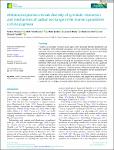Metatranscriptomics reveals diversity of symbiotic interaction and mechanisms of carbon exchange in the marine cyanolichen <i>Lichina pygmaea</i>
| dc.contributor.author | Chrismas, N | |
| dc.contributor.author | Tindall‐Jones, B | |
| dc.contributor.author | Jenkins, H | |
| dc.contributor.author | Harley, J | |
| dc.contributor.author | Bird, K | |
| dc.contributor.author | Cunliffe, M | |
| dc.date.accessioned | 2023-11-02T19:11:53Z | |
| dc.date.available | 2023-11-02T19:11:53Z | |
| dc.date.issued | 2023 | |
| dc.identifier.issn | 0028-646X | |
| dc.identifier.issn | 1469-8137 | |
| dc.identifier.uri | https://pearl.plymouth.ac.uk/handle/10026.1/21565 | |
| dc.description.abstract |
Lichens are exemplar symbioses based upon carbon exchange between photobionts and their mycobiont hosts. Historically considered a two-way relationship, some lichen symbioses have been shown to contain multiple photobiont partners; however, the way in which these photobiont communities react to environmental change is poorly understood. Lichina pygmaea is a marine cyanolichen that inhabits rocky seashores where it is submerged in seawater during every tidal cycle. Recent work has indicated that L. pygmaea has a complex photobiont community including the cyanobionts Rivularia and Pleurocapsa. We performed rRNA-based metabarcoding and mRNA metatranscriptomics of the L. pygmaea holobiont at high and low tide to investigate community response to immersion in seawater. Carbon exchange in L. pygmaea is a dynamic process, influenced by both tidal cycle and the biology of the individual symbiotic components. The mycobiont and two cyanobiont partners exhibit distinct transcriptional responses to seawater hydration. Sugar-based compatible solutes produced by Rivularia and Pleurocapsa in response to seawater are a potential source of carbon to the mycobiont. We propose that extracellular processing of photobiont-derived polysaccharides is a fundamental step in carbon acquisition by L. pygmaea and is analogous to uptake of plant-derived carbon in ectomycorrhizal symbioses. | |
| dc.format.extent | 2243-2257 | |
| dc.format.medium | Print-Electronic | |
| dc.language | en | |
| dc.publisher | Wiley | |
| dc.subject | carbon | |
| dc.subject | Cyanobacteria | |
| dc.subject | lichens | |
| dc.subject | Lichina pygmaea | |
| dc.subject | marine | |
| dc.subject | symbiosis | |
| dc.title | Metatranscriptomics reveals diversity of symbiotic interaction and mechanisms of carbon exchange in the marine cyanolichen <i>Lichina pygmaea</i> | |
| dc.type | journal-article | |
| dc.type | Article | |
| dc.type | Early Access | |
| plymouth.author-url | https://www.ncbi.nlm.nih.gov/pubmed/37840369 | |
| plymouth.issue | 5 | |
| plymouth.volume | 241 | |
| plymouth.publication-status | Published online | |
| plymouth.journal | New Phytologist | |
| dc.identifier.doi | 10.1111/nph.19320 | |
| plymouth.organisational-group | |Plymouth | |
| plymouth.organisational-group | |Plymouth|Faculty of Science and Engineering | |
| plymouth.organisational-group | |Plymouth|Faculty of Science and Engineering|School of Biological and Marine Sciences | |
| plymouth.organisational-group | |Plymouth|REF 2021 Researchers by UoA | |
| plymouth.organisational-group | |Plymouth|Users by role | |
| plymouth.organisational-group | |Plymouth|Users by role|Academics | |
| plymouth.organisational-group | |Plymouth|REF 2021 Researchers by UoA|UoA07 Earth Systems and Environmental Sciences | |
| dc.publisher.place | England | |
| dcterms.dateAccepted | 2023-09-21 | |
| dc.date.updated | 2023-11-02T19:11:27Z | |
| dc.rights.embargodate | 2023-11-4 | |
| dc.identifier.eissn | 1469-8137 | |
| rioxxterms.versionofrecord | 10.1111/nph.19320 |


